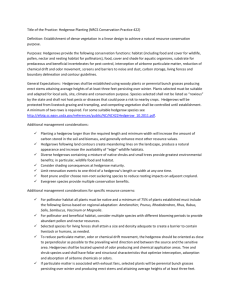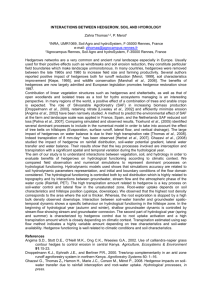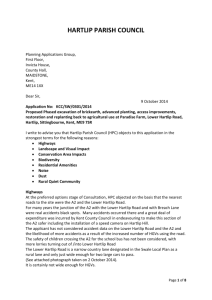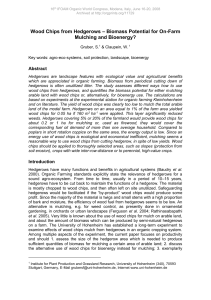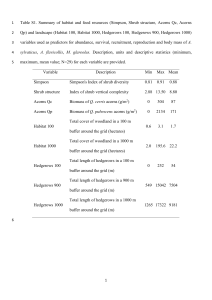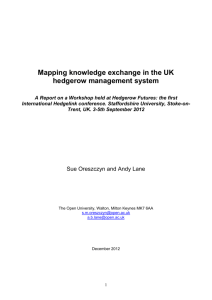Biodiversity Action Plan species linked to hedgerows
advertisement
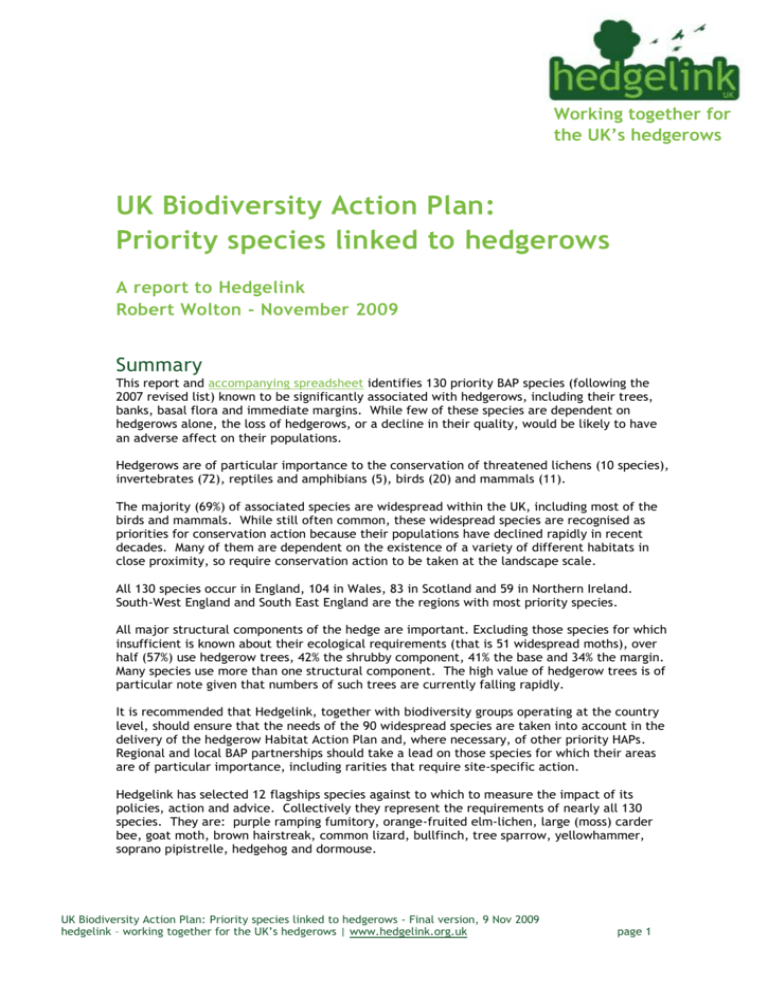
Working together for the UK’s hedgerows UK Biodiversity Action Plan: Priority species linked to hedgerows A report to Hedgelink Robert Wolton - November 2009 Summary This report and accompanying spreadsheet identifies 130 priority BAP species (following the 2007 revised list) known to be significantly associated with hedgerows, including their trees, banks, basal flora and immediate margins. While few of these species are dependent on hedgerows alone, the loss of hedgerows, or a decline in their quality, would be likely to have an adverse affect on their populations. Hedgerows are of particular importance to the conservation of threatened lichens (10 species), invertebrates (72), reptiles and amphibians (5), birds (20) and mammals (11). The majority (69%) of associated species are widespread within the UK, including most of the birds and mammals. While still often common, these widespread species are recognised as priorities for conservation action because their populations have declined rapidly in recent decades. Many of them are dependent on the existence of a variety of different habitats in close proximity, so require conservation action to be taken at the landscape scale. All 130 species occur in England, 104 in Wales, 83 in Scotland and 59 in Northern Ireland. South-West England and South East England are the regions with most priority species. All major structural components of the hedge are important. Excluding those species for which insufficient is known about their ecological requirements (that is 51 widespread moths), over half (57%) use hedgerow trees, 42% the shrubby component, 41% the base and 34% the margin. Many species use more than one structural component. The high value of hedgerow trees is of particular note given that numbers of such trees are currently falling rapidly. It is recommended that Hedgelink, together with biodiversity groups operating at the country level, should ensure that the needs of the 90 widespread species are taken into account in the delivery of the hedgerow Habitat Action Plan and, where necessary, of other priority HAPs. Regional and local BAP partnerships should take a lead on those species for which their areas are of particular importance, including rarities that require site-specific action. Hedgelink has selected 12 flagships species against to which to measure the impact of its policies, action and advice. Collectively they represent the requirements of nearly all 130 species. They are: purple ramping fumitory, orange-fruited elm-lichen, large (moss) carder bee, goat moth, brown hairstreak, common lizard, bullfinch, tree sparrow, yellowhammer, soprano pipistrelle, hedgehog and dormouse. UK Biodiversity Action Plan: Priority species linked to hedgerows - Final version, 9 Nov 2009 hedgelink – working together for the UK’s hedgerows | www.hedgelink.org.uk page 1 Working together for the UK’s hedgerows Contents 1. 2. 3. 4. 5. 6. 7. 8. 9. 10. 11. Introduction Defining significant associations between species and habitats Species significantly associated with hedgerows Geographic distribution across UK How the species use hedgerows, and implications for hedgerow management 5.1. General points 5.2. Hedgerow trees 5.3. Shrubby component 5.4. Hedgerow base (including any bank) 5.5. Hedgerow margin Other species of conservation concern linked to hedgerows 6.1. Species which use hedgerows but are not dependent on them 6.2. Species of regional or local conservation significance Responsibility for priority species Flagship species Recommendations Key references Acknowledgements Table 1. Table 2. hedges Table 3. Table 4. Table 5. Numbers of priority species linked to hedgerows by major taxonomic group Numbers of priority species associated with the different structural components of Species associated with hedgerows but not thought dependent on them Examples of species of conservation concern without priority UK BAP status Recommended flagship species See accompanying spreadsheet for list of priority species linked with hedgerows, together with notes on their ecology, distribution and status. It also gives the main sources of information used. UK Biodiversity Action Plan: Priority species linked to hedgerows - Final version, 9 Nov 2009 hedgelink – working together for the UK’s hedgerows | www.hedgelink.org.uk page 2 Working together for the UK’s hedgerows 1. Introduction The formal adoption of the revised UK list of priority species and habitats by all four country administrations in August 2007, eleven years after the first list was produced, has required that those leading the delivery of habitat action plans, at both national and local levels, should take increased responsibility at the species level. This is reflected, for example, in the England Biodiversity Framework. A review of hedgerow species of particular conservation concern is required now, for two main reasons. Firstly, the new definition of the priority habitat covers all hedges composed predominantly of native species, not just ancient and/or species-rich ones, so has a broader remit. Secondly, the number of species on the priority list increased hugely from 391 to 1150. Although a few species have been dropped, many more have been added. This increase means that it is no longer practical for every species, or group of species, to have its own set of people or organisations responsible for it. Instead, those leading the delivery of habitat action plans such as UK HAP groups or country groups (eg Biodiversity Integration Groups (BIGs) in England), are expected to take increased responsibility for promoting appropriate species conservation action. This report, together with that by Webb, Drewitt and Measures (in prep. 2009), presents information on which of the 1150 priority species are significantly associated with hedgerows, and through analysis of their habitat requirements, draws conclusions on the approach that should be taken to their conservation. 2. Defining significant associations between species and habitats In this report a species is considered to be significantly associated with hedgerows if the loss of hedgerows, or a reduction in their quality, would be likely to lead to population reduction or range contraction. To be significantly associated with hedgerows, individual species can use them in a variety of ways. These include using hedgerows as a source of food, for shelter and refuge from predators, for breeding, and for display purposes such as song-posts. Hedgerows are taken to include hedgerow trees and associated banks, ditches and field margins, as well as the classic shrubby component, in line with the UK HAP. No attempt has been made to develop hard criteria for inclusion of species in the list. Rather expert opinion has been sought. On a few occasions so little is known about a rare species that it cannot be said for certain whether it uses hedgerows or not. However, if available evidence suggests that it is highly likely to, other than on an incidental basis, then the species has been included. UK Biodiversity Action Plan: Priority species linked to hedgerows - Final version, 9 Nov 2009 hedgelink – working together for the UK’s hedgerows | www.hedgelink.org.uk page 3 Working together for the UK’s hedgerows 3. Species significantly associated with hedgerows The accompanying spreadsheet lists those species known to, or considered likely to, have significant dependency on hedgerows. A total of 130 species have been identified, 11% of the total. The spreadsheet contains information about the ecology, distribution and status of each of the species, and on why they have been identified as priorities for conservation action. Some details are also given on how they use hedgerows and, in the case of animals, on their diet. It is probable that a few further species, particularly among the lichens, fungi and invertebrates will be found to have important associations with hedgerows once more is known about them. The 130 species are spread across a wide range of high level taxonomic groupings, as shown in Table 1. The only major terrestrial groups not known to be represented are the molluscs and spiders, apart from a few of non-insect invertebrate groups (eg centipedes and millipedes) that contain just a few priority species. Table 1. Numbers of priority species linked to hedgerows by major taxonomic group Taxonomic group Number of priority species associated with hedgerows Bryophytes 1 Vascular plants 7 Fungi 4 Lichens 10 Insects 72 Amphibians and reptiles 5 Birds 20 Mammals 11 Total 130 Over two thirds (69%, 90/130) of the species that have been included are widespread, occurring in two or more regions in the UK, and some remain common. They are all considered priorities for conservation action because they have rapidly declining populations (a greater than 50% loss in a recent 25 year period). Among these are 51 species of larger moth which feed as larvae on plants frequently associated with hedgerows. Three out of five species of bumblebee, and all six amphibians and reptiles, also fall into this category as do most of the 20 birds, the sole exceptions being red-backed shrike Lanius collurio and cirl bunting Emberiza cirlus. The remaining species are either rare, sometimes very rare, or scarce with restricted distributions. All nine lichens and four of the vascular plants, bastard balm Melittis melissophyllum, copse bindweed Fallopia dumetorum, crested cow-wheat Melampyrum cristatum and purple ramping fumitory Fumaria purpurea are included in this latter, scarce and restricted, category. Four out of five fungi, the two remaining vascular plants Plymouth pear Pyrus cordata and starved wood-sedge Carex depauperata, round-leaved feather-moss Rhynchostegium rotundifolium, the hoverfly Callicera spinolae and Bechstein’s bat Myotis bechsteinii are among the very rare species. UK Biodiversity Action Plan: Priority species linked to hedgerows - Final version, 9 Nov 2009 hedgelink – working together for the UK’s hedgerows | www.hedgelink.org.uk page 4 Working together for the UK’s hedgerows 4. Geographic distribution All 130 priority species are found in England, 104 in Wales, 83 in Scotland and 59 in Northern Ireland. (The number found in Northern Ireland may be an over-estimate since it is assumed that of the 50 widespread moths that occur in Ireland as a whole, all are found in Northern Ireland.) A full analysis by region has not been carried out, but a strong southern bias is apparent. This is confirmed by Webb et al (2009) who show that the South-West and South-East support many more hedgerow priority species than other English regions. South-East England appears to have particular responsibility among the higher plants, and East England region for fungi. 5. The different structural components of hedgerows used by the species, and implications for hedgerow management 5.1 General points Webb et al (2009) observe that many of the widespread species associated with hedgerows require landscape-scale habitat mosaics of different habitats. This is particularly true for the birds and mammals listed. Conserving any one habitat in isolation will be unlikely to reverse the fortunes of these species. Webb et al also note that the conservation of a full complement of hedgerow species requires a high degree of structural diversity in the landscape, as is indeed true for most other habitats. A variety of different hedgerow structures is needed in close proximity: management should aim to achieve this and not focus solely on the species composition of the plant communities present. Likewise, they note that individual species often use several parts of the hedge. Yellowhammers, for example, feed in the margins, nest in the base, hide from predators in the shrubby part, and use trees as song posts. This report confirms these acute observations. An analysis of the number of species associated with the different parts of hedges is given in Table 2. Hedgerow component Tree Shrub layer Base Margin Associated number of priority species (n = 79) 45 33 32 27 Percentage of priority species associated with the hedge component 57 42 41 34 Table 2. Numbers of priority species associated with the different structural components of hedges. The 51 widespread moths have been excluded from this analysis because insufficient information is known about their habitat requirements. The percentages add up to more than 100% because many species use more than one component. UK Biodiversity Action Plan: Priority species linked to hedgerows - Final version, 9 Nov 2009 hedgelink – working together for the UK’s hedgerows | www.hedgelink.org.uk page 5 Working together for the UK’s hedgerows 5.2 Hedgerow trees Over half 57% (45/79) of all priority species are dependent on, or partially dependent on, hedgerow trees. This must be of particular interest given the perilous state of the tree population at present. Mature and veteran trees are of particular importance, providing a suitable substrate for all the lichens and sole moss, feeding habitat for the larvae of the heart moth Dicycla oo, rot holes for the hoverfly Callicera spinolae, feeding and lekking grounds for adults of the two hairstreak butterflies, a vantage point for birds like yellowhammer Emberiza citrinella, tree pipit Anthus trivialis and cuckoo Cuculus canorus to sing and display from, and nesting holes for birds like tree sparrow Passer montanus and bats like the barbastelle Barbastella barbastellus. Clearly, action taken to increase the number of hedgerow trees is likely to be of benefit to many species, even if the trees are not for some a limiting factor to population growth. One of the priority species is a hedgerow tree itself, the very rare Plymouth pear! A wider range of priority lichens are associated with wayside trees – those that grow alongside roads and other highways that are not set within hedgerows – than on hedgerow trees themselves. This is because trees in hedgerows often have their lower trunks heavily shaded by the surrounding hedgerow shrubs or by ivy rending their bark unsuitable for colonisation by the lichens. Examples of priority lichens found on wayside trees include Caloplaca flavorubescens, Catapyrenium psoromoides, Chaenotheca gracilenta, Chaenotheca laevigata, Fuscopannaria ignobilis, Gyalecta ulmi, Leptogium saturninum, Ramonia dictyospora, Thelenella modesta, Wadeana dendrographa and Wadeana minuta. Many wayside trees are remnants of former hedgerows: we may expect some of these lichens to be found on hedgerow trees especially where the shrub layer beneath mature trees has thinned to form gaps. The close association of many of these lichens with elms is of particular note, since mature elms are not found within closed-canopy woodlands. 5.3 Shrubby component 42% (33/79) of species use the shrubby component of hedgerows, for feeding, breeding or shelter and protection from weather and predators. Available evidence suggests that for the majority of vertebrates the dense cover provided by a well managed shrubby hedgerow is important. A decline in the quality of hedgerows, making their interiors more open and exposed to predators, has been implicated in the decline of dormice and of a number of rapidly declining farmland birds such as turtle dove Streptopelia turtur, bullfinch Pyrrhula pyrrhula and linnet Carduelis cannabina. It is probable that dense bushy hedgerows will also be preferred by a number of invertebrates such as the brown hairstreak Thecla betulae, but evidence on this appears thin. Continuity of habitat has been shown to be important for dormouse Muscardinus avellanarius and for bats, especially the smaller species such as the pipistrelles Pipistrellus spp. – they turn back when they encounter gaps – and appears to be important for dispersing polecats Mustela putorius. UK Biodiversity Action Plan: Priority species linked to hedgerows - Final version, 9 Nov 2009 hedgelink – working together for the UK’s hedgerows | www.hedgelink.org.uk page 6 Working together for the UK’s hedgerows Hedgerows are importance to all the bats listed, not just as areas rich in the flying insects on which they largely feed, but also as flyways, creating safe, sheltered, dark, routes along which they can navigate and avoid predators. Populations of greater horseshoe bats Rhinolophus ferrumequinum have responded well to targeted environmental schemes that have included hedgerow restoration (as has the cirl bunting Emberiza cirlus). Many other flying animals are also likely to use hedgerows as aids to moving around the landscape: the pale shining brown moth Polia bombycina is one example. 5.4 Hedgerow base (including any bank) The base of hedgerows, beneath the canopy, is important for 41% (32/79) of priority species. These include all four herbaceous plants and the very rare starved wood-sedge, three of the fungi, the herptiles (newts, toads, lizards and snakes) and a number of birds. Great-crested newts Triturus cristatus and common toads Bufo bufo, generally thought to be closely associated with ponds, in fact for the most part only spend the breeding season in such aquatic habitats. Otherwise, like the grass snake Natrix natrix and Common lizard Zootoca vivipara, they move along, forage within and over-winter in the base of hedgerows and associated ditches, along with other linear features in the landscape. Grey partridge Perdix perdix and the three bunting species, cirl bunting, yellowhammer Emberiza citrinella and reed bunting Emberiza schoeniclus, all nest on or close to the base of hedges, the yellowhammer showing a preference early in the season for the dense cover provided on ditch sides. The hedgerow bottom is also important for hibernating dormice, and probably also as a safe place to spend the winter for the five bumblebee species. Hedgehogs Erinaceus europaeus forage for invertebrates and other prey along the base of hedgerows. Generally, for the birds, herptiles and mammals a dense herb or grass cover is preferred. However, for the vascular plants and fungi such as Sandy stilt puffball Battarrea phalloides, several of which are associated with banks, a more open situation is generally preferred, dense shade and competition both causing problems. This difference in requirements highlights the needs for managers to be aware of which special species are present or likely to be present, and to adjust their management accordingly. 5.5 Hedgerow margin Moving beyond the confines of the canopy, the margins associated with hedgerows are important for 34% (27/79) of priority species. The herbs and grasses within them provide nectar, pollen for the bumblebees, and seeds and invertebrates for the majority of the priority birds including grey partridge Perdix perdix, turtle dove, song thrush Turdus philomelos, marsh tit Poecile palustris, starling Sturna vulgaris, house sparrow Passer domesticus, tree sparrow and all the finches and buntings. Harvest mice Micromys minutus build their nests in the long grass and other tall vegetation in hedgerow bases and margins. It is clear that creating or maintaining herb-rich margins will be of benefit to all these species. UK Biodiversity Action Plan: Priority species linked to hedgerows - Final version, 9 Nov 2009 hedgelink – working together for the UK’s hedgerows | www.hedgelink.org.uk page 7 Working together for the UK’s hedgerows 6. Other species of conservation concern linked to hedgerows 6.1 Species which use hedgerows but are not dependent on them There are many priority species which may be found in hedges from time to time, but whose populations are unlikely to fall if hedges alone are removed from the landscape. Examples of these are given in Table 3. Common name Grasshopper warbler Corn bunting Latin name Locustella naevia Brown hare Lepus europaeus White-spotted pinion moth Cosmia diffinis A crab spider Emberiza calandra Philodromus margaritatus A lace bug Physatocheila smreczynskii A lichen Gyalecta ulmi Comments Occurs mainly in non-hedgerow scrub and tall fen, but occasionally in hedgerows Occasionally uses hedgerow bushes and trees as song posts, but nests and feeds infield and uses other features for song posts as well These hares occupy large scale habitat mosaics which include hedges, otherwise they tend to avoid hedges The larvae of this moth feed on elms in woods, copses, plantations and shelter belts, and could occur in hedges Occurs on the bark and foliage of lichen covered trees and may be found on hedgerow trees Found on old lichen-covered apple trees in old orchards and on crab apple in woodlands – may occur on hedgerow trees Used to occur on wayside elms, now apparently confined to calcareous cliffs Table 3. Species associated with hedgerows but not thought dependent on them 6.2 Species of regional or local conservation significance Priority BAP species are those which have been identified as being most in need or urgent conservation action at the UK level. However, there are many other species of conservation concern which have significant associations with hedgerows. Some of these will be very rare, being restricted to just a handful of places, other will be widespread and declining (but more slowly than priority species). Still others will be distinctive feature of a particular area yet facing an uncertain future. Identifying these second-tier species is beyond the scope of this report, but it is to be hoped that those developing and implementing regional and local BAPs will try and identify those for which their area is of particular importance, and take appropriate action. A selection of such species is given in Table 4. UK Biodiversity Action Plan: Priority species linked to hedgerows - Final version, 9 Nov 2009 hedgelink – working together for the UK’s hedgerows | www.hedgelink.org.uk page 8 Working together for the UK’s hedgerows Table 4. Examples of species of conservation concern without priority UK BAP status Common name Primrose Latin name Primula vulgaris Roman snail Helix pomata Small eggar moth Eriogaster lanestris Black hairstreak Satyrium pruni Barn owl Tyto alba Stoat Mustela erminea Comments A characteristic spring flower of hedge banks in the West Country, but thought to be declining This mollusc, now specially protected under the Wildlife and Countryside Act, is present in scrubby hedges on the North Downs, Chilterns, Cotswolds and parts of the Mendips. A nationally scarce moth whose larvae live in silken tents on the new growth of blackthorn and hawthorn in hedges. May be declining because of annual hedge cutting. A rare butterfly which feeds on blackthorn in woodland glades and edges and occasionally hedgerows This charismatic owl hunts along hedgerow margins. Populations are currently low and the species is very vulnerable to changes in land and building use Like the weasel Mustela nivalis, the stoat hunts along hedges. Following heavy persecution and myxomatosis numbers recovered for a while but there are indications numbers are now in decline again. 7. Responsibility for priority species As already noted, it is not proposed that all priority species should have action plans or targets, but rather that wherever possible the needs of these species should be integrated into delivery of priority habitat action plans. Each country is expected to put in place mechanisms to monitor their conservation status and to take appropriate action. For the majority of the 130 species we have at least some understanding about what needs to be done to enable populations to recover or at least stabilise. For those that are widespread conservation action should be initiated by appropriate country groups (eg the Lowland Farmland BIG in England) and Hedgelink, seeking support from regional and local BAP partnerships For those species with restricted distributions, action should be led at the regional or local level. Such local action is particularly important for rare and highly localised species that require site-specific attention to ensure continued survival in the UK. UK Biodiversity Action Plan: Priority species linked to hedgerows - Final version, 9 Nov 2009 hedgelink – working together for the UK’s hedgerows | www.hedgelink.org.uk page 9 Working together for the UK’s hedgerows For a number of species including all 51 widespread yet rapidly declining moths, insufficient is known about the reasons for decline for any action to be currently proposed beyond research. This is being led at a UK level at the instigation of the UK Biodiversity Research Advisory Group (BRAG). 8. Flagship species Clearly with so many widespread species having a significant association with hedgerows it would be impractical to consider the needs of each while developing policy or delivery initiatives, whether at UK, country regional or local level. The solution to this lies in identifying a small number of key, or flagship, species. Hedgelink has agreed that UK flagship hedgerow species should meet at least four of the following criteria: 1. Be widely distributed within the UK, preferably occurring in at least three countries 2. Require the same habitat conditions as a suite of priority species 3. Require hedgerows to be in favourable condition, either at an individual level or at a landscape level, or preferably both. 4. Be sufficiently well understood for effective conservation action to be taken now 5. Have a high public profile, or be sufficiently interesting or appealing to attract public interest In addition, collectively the flagship species should use each of the main structural components of hedgerows (tree, shrub, bank/base, margin), and include representatives of each of the main taxonomic groups. Table 5 (see end of report) presents the choice of 12 flagship species agreed by the UK Hedgerow Habitat Action Plan group (Hedgelink) in October 2009. 9. Recommendations In conclusion, it is recommended that: 1. That the UK HAP Steering Group (Hedgelink) should consider the requirements of widely distributed priority species significantly associated with hedgerows when developing policies, formulating initiatives and promoting action to deliver the targets in the hedgerow HAP. 2. That attention is focussed on the selected twelve flagship species, chosen to be representative of the full range of widely-distributed species. 3. That regional and LBAP partnerships should consider in particular the requirements of narrowly-distributed species for which their areas are of special importance, including rarities. 4. That LBAP partnerships should also consider the needs of species of conservation concern which are not recognised as priorities by the UK BAP but which are of particularly concern locally. UK Biodiversity Action Plan: Priority species linked to hedgerows - Final version, 9 Nov 2009 hedgelink – working together for the UK’s hedgerows | www.hedgelink.org.uk page 10 Working together for the UK’s hedgerows 10. Key references Evidence for the selection of priority species. Follow link to Stage 1 species evidence on UK BAP Website Managing priority habitats for invertebrates. 2003. Unpublished report by Buglife to Defra. National Biodiversity Network's Gateway Report on the Species and Habitat Review. June 2007. Report to the UK Biodiversity Partnership. Biodiversity Reporting and Information Group. UK List of Priority Species and Habitats Webb, J.R., Drewitt, A.L., & Measures, G.H. A future for species: Integrating UK BAP species into habitat action plans. In preparation. Expected publication as Natural England Research Report in 2009. Final draft (Oct 09) seen. 11. Acknowledgements I am very grateful to the following specialists who have given their time to let me know which priority species are associated with hedgerows; Heather Robertson (vascular plants and birds), Ron Porley (bryophytes), Sandy and Brian Coppins (lichens), Nev Kilkenny and Stephan Helfer (fungi), David Sheppard (Hymenoptera), Roger Key (Coleoptera), Roger Morris (Diptera), Mark Parsons (moths), John Dover (butterflies), Phil Grice (birds) and Tony Mitchell-Jones (mammals). Without their help, this project would not have been possible. I would also like to express my thanks to Defra for part-funding this work. I also acknowledge the helpful analysis carried out by Jon Webb, Allan Drewitt and Gavin Measures of Natural England, to be published as a Natural England Research Report, which has informed this work. Report written by: Dr Robert Wolton Locks Park Farm Hatherleigh Devon EX20 3LZ robertwolton@yahoo.co.uk Telephone 01837 810416 UK Biodiversity Action Plan: Priority species linked to hedgerows - Final version, 9 Nov 2009 hedgelink – working together for the UK’s hedgerows | www.hedgelink.org.uk page 11 Working together for the UK’s hedgerows Table 5. Hedgelink’s Flagship priority hedgerow species E England, W Wales, S Scotland, NI Northern Ireland. Species High level taxa Distrib ution Status Main hedgerow parts used Ecological requirements Priority species with similar habitat requirements Purple ramping fumitory Fumaria purpurea Vascular plant E, W, S, NI Nationally scarce, endemic Base (including bank) Herbaceous flora in favourable condition Orange-fruited elmlichen Caloplaca luteoalba Large (Moss) Carder bee Bombus muscorum Brown hairstreak butterfly Thecla betulae Goat moth Cossus cossus Lichen E, W, S Tree Invert E, W, S, NI Viable tree population structure, including veteran trees Pollen and nectar-rich herbaceous margins Invert E, W Nationally scarce, schedule 8, declining Nationally scarce, rapidly declining Widespread, rapidly declining Vascular plants and fungi that grow at the base of hedges and will not tolerate dense shade or nutrient enrichment and/or which require some soil disturbance Lichens and mosses that grow on mature tree trunks, including trees that occur mainly in hedgerows such as elm Bumble-bees and other invertebrates that feed on flowers in hedgerow margins (as well as on hedgerow shrubs) Invertebrates that require thick, shrubby hedges that are cut but infrequently so Invert E, W, S Tree Common lizard Zootoca vivipara Reptile E, W, S, NI Widespread, declining, nationally scarce Widespread Bullfinch Pyrrhula pyrrhula Bird E, W, S, NI Widespread, declining, Red listed, Woodland Bird Indicator Species Shrubby part Margin Shrubby part Base and margin UK Biodiversity Action Plan: Priority species linked to hedgerows - Final version, 9 Nov 2009 hedgelink – working together for the UK’s hedgerows | www.hedgelink.org.uk Favourable hedgerow dimensions, structure and cutting frequency Viable hedgerow tree population Hedgerow bases and margins which provide good cover and plentiful invertebrate food Favourable hedgerow dimensions, structure and cutting frequency page 12 Invertebrates which require viable populations of trees in the landscape, including hedgerow trees Reptiles, amphibians and other animals which require high levels of hedgerow connectivity and landscape-scale conservation Farmland or woodland birds that require dense hedges to nest in and seeds, berries or insects for food, such as other finches, the hedge accentor (dunnock) and marsh and willow tits Working together for the UK’s hedgerows Species High level taxa Distrib ution Status Main hedgerow parts used Ecological requirements Priority species with similar habitat requirements Tree sparrow Passer montanus Bird E, W, S, NI Tree Viable tree population structure, including veteran trees Hole nesting birds and bats dependent on mature or veteran trees, species dependent on dead wood such as the stag beetle, and other species that require mature trees such as the heart moth. Yellowhammer Emberiza citrinella Bird E, W, S, NI Base and margin Presence of undisturbed ground and favourable herbaceous flora Farmland birds that nest and feed on the ground, taking seeds and other plant material and invertebrates, like grey partridge and other buntings Soprano pipistrelle Pipistrellus pygmaeus Mammal E, W, S, NI Entire hedge Continuity of hedgerows at individual and landscape levels Animals that require intact hedges and well hedged landscapes, like other bats and probably many moths Hedgehog Erinaceus europaeus Mammal E, W, S, NI Widespread, declining, Red listed, Farmland Bird Indicator Species Widespread, declining, Red listed, Farmland Bird Indicator Species Widespread, declining, BAP indicator species, European Protected Species Widespread, declining Base and margin Dormouse Muscardinus avellanarius Mammal E, W Nationally scarce, declining, European Protected Species Shrubby part Presence of undisturbed ground and favourable herbaceous flora, and landscape continuity Favourable hedgerow dimensions, structure and cutting frequency Animals that feed on ground-living invertebrates or other animals in hedgerow bases, and that require continuity of foraging habitat at landscape scale, such as the polecat, amphibians and reptiles Animals that require plentiful supplies of flowers, berries and nuts and dense cover for nesting, and continuity of hedgerows at individual and landscape level UK Biodiversity Action Plan: Priority species linked to hedgerows - Final version, 9 Nov 2009 hedgelink – working together for the UK’s hedgerows | www.hedgelink.org.uk page 13
![the Hedgerows Factsheet [MSWORD 2007 16kb]](http://s3.studylib.net/store/data/006673671_1-d612e3440b4640173c263081aea7871b-300x300.png)
